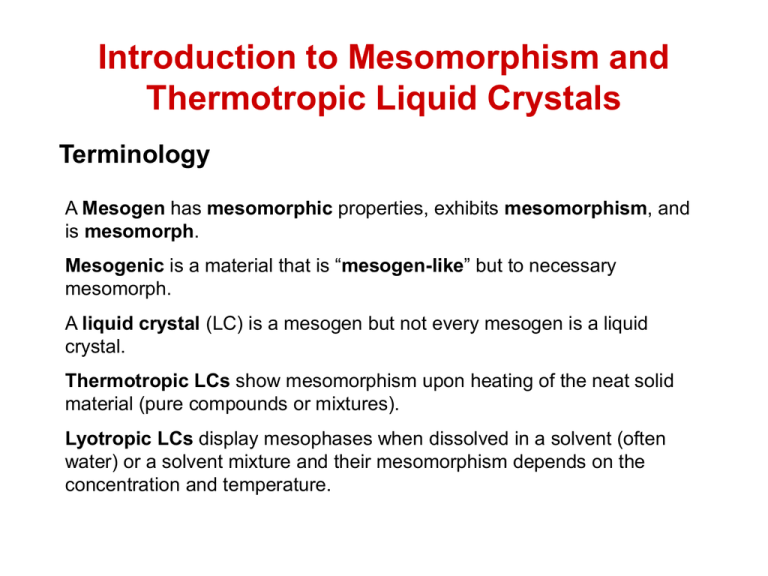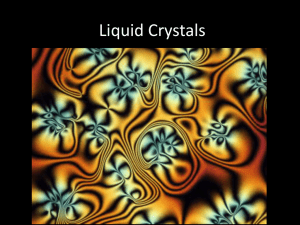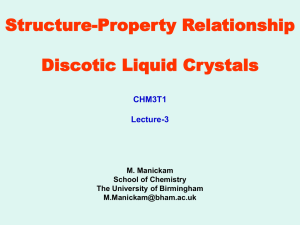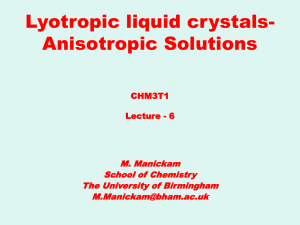Introduction to Mesomorphism and Thermotropic Liquid Crystals
advertisement

Introduction to Mesomorphism and Thermotropic Liquid Crystals Terminology A Mesogen has mesomorphic properties, exhibits mesomorphism, and is mesomorph. Mesogenic is a material that is “mesogen-like” but to necessary mesomorph. A liquid crystal (LC) is a mesogen but not every mesogen is a liquid crystal. Thermotropic LCs show mesomorphism upon heating of the neat solid material (pure compounds or mixtures). Lyotropic LCs display mesophases when dissolved in a solvent (often water) or a solvent mixture and their mesomorphism depends on the concentration and temperature. States of Matter low temperature solids high temperature liquids gases plasmas MESOPHASES liquid crystals • 0-2D l.-r. positional order • l.-r. orientational order • macroscopic fluidity ? soft & plastic crystal phases • 3D l.-r. positional order • reduced l.-r. orientational order • macroscopic plasticity low-dimensional solids (e.g. soft polymer glasses) • no 3D l.-r. positional order • no l.-r. orientational order • macroscopic plasticity ? Order of N, Sm, and Col Mesophases director ^ n orientational order no positional order N 1D positional order Colh 2D positional order SmA calamitic discotic Calamitic LCs Molecules with an elongated rigid core (one molecule axis is much longer than the other two; high aspect ratio) Discotic LCs Disc-shaped molecules (one molecule axis is much shorter than the other two; low aspect ratio) Nematic (N) LCs (Gr. for thread-like) Discotic nematic (ND) mesophases Smectic (Sm) LCs (Gr. for soap-like) Discotic columnar (Col) mesophases Main- & side-chain calamitic LC polymer Main- & side-chain discotic LC polymer Rigid-rod and board-shaped LC polymers Chiralety and Mesophases The mesophase is marked with an Asterisks if it contains one enantiomer of a chiral molecule, which could be a dopant or the LC itself. However, a mesophase containing chiral molecules does not necessary show chiral bulk properties (e.g. racemic mixtures). The chiral nematic phase (N*) is also called cholesteric phase. Polymorphism of Smectic Mesophases Non-tilted (uniaxial) Tilted (biaxial) In plane order Molecular rotation SmA SmC none unhindered Hexatic B (or SmB) Hexatic F, I (or SmF, I) bond orientational order unhindered Crystal B Crystal G, F positional unhindered Crystal E Crystal H, K positional hindered Collings PJ and Michael H, Introduction to LCs, Taylor & Francis, 1997. Structure of Chiral Mesophases N* or cholesteric mesophase A pitch can be as small as 100 nm, as large as 10 mm, and varies with temperature. Chiral smectic C (SmC*) phases Collings PJ and Michael H, Introduction to LCs, Taylor & Francis, 1997. Polymorphism of Discotic Mesophases uniaxial uniaxial biaxial Discotic nematic (ND) biaxial uniaxial Discotic hexagonal columnar Colh or Dh Colho ordered; Colhd disordered Discotic oblique columnar Colob or Dob (Colh plastic crystal) Discotic rectangular and tetragonal columnar Colr or Dr; Colt or Dt An ordered molecular arrangement within a column requires a persistence length of at least 20-30 molecules Thermotropic mesomorphism governed by molecular design Microphase separation Shape anisotropy H H O O N F F O O O O O n rods hydro- and fluorocarbons do not display mesomorphism discs hard-rod potential by Onsager: Ann. New York Acad. Sci. 51 (1949), 627 not mesomorph F F H H n Intermolecular interactions O n O m semifluorinated n-alkanes display soft crystal phases CN dipole-dipole interaction induced mesomorphism Liquid Crystals of Unusual Shape NC CN NC CN CN CN NC O C O C 11H 23 HO H 25C 12O CN NC SmA layers CN NC O O C 12 H 25 NC O O NC O NC NC O C 12 H 25 O C H 12 25 OO O NC Triptycene derivative (Epitaxygen) Norvez et al. Liq. Cryst. 14 (1993), 1389 O O NC O OO O O O O CN O O O O O O OO O O O OO O O O O O O O O O Si Si O Si O O OO S i O O O O O Si O Si Si O Si O O O O Si O O O O O O Si Si Si Si O O O O O O S i OOO O Si Si Si O OO O O O O O O O O O O O O O OO O O O CN O O CN O O CN CN O O CN O O CN O O NC O O O OO O O CN NC CN NC Cl CN Cl CN NC CN CN CN CN CN Dendrimeric liquid crystal (SmA) Lorenz et al., Adv. Mater. 8 (1996), 414 Cl Discotic liquid crystal without side-chains (Colh) Barberá at al., Angew. Chem. Int. Ed. 37 (1998), 296 Introduction to Lyotropic Liquid Crystals Thermotropic LCs show mesomorphism upon heating of the neat solid material (pure compounds or mixtures). Lyotropic LCs display mesophases when dissolved in a solvent (often water) or a solvent mixture and their mesomorphism depends on the concentration and temperature. The term lyotropic stems from the Greek word for solve. The Hydrophobic Effect The entropy of water is exceptionally high and the tetrahedral network of water molecules, maintained by hydrogen bonds, can accommodate small guest molecules in its cavities. Large solute molecules brake the hydrogen bonds between adjacent molecules which is a enthalpy-costly process. Most often, the entropy of mixing can not overcompensate the enthalpy-loss for solved molecules that do not form hydrogen bonds. This is why hydrocarbons show very low solubility in water. They are expelled from the water phase. All pictures taken from H. Stegemeyer, “Liquid Crystals”, Topics in Physical Chemistry; Steinkopff Darmstadt, Springer New York, 1994 Molecular Structure of Surfactants Examples for amphiphilic molecules, composed of a polar hydrophilic headgroup and a hydrophobic tail. Aggregation of Surfactants solution micellar “solution” solid CMC = Critical Micelle Concentration Surfactant molecules start aggregating in water at rather low concentration. Both of the two parts of the amphiphilic molecules profit by gathering into locally hydrophobic and hydrophilic micro-domains. Micelles, “finite” size dynamic aggregates of 50 up to several hundred molecules, can only exist at temperatures above the Krafftpoint temperature (TK). The normal micelle turns into a reverse micelle at high surfactant concentrations confining the remaining water molecules to its now hydrophilic interior. Structures of micellar aggregates and lyotropic mesophases of rodshaped surfactants. Disc-shaped water soluble, but nonamphiphilic, ionic aromatic pharmaceuticals also self-organize into p,p-stacks that form lyotropic mesophases (“chromonics”). Phase Diagrams of Surfactants in Water Isotropic normal/inverse micelles (L1/L2), Isotropic bicontinuous (sponge) (L3); Hexagonal normal/inverse (H1/H2); Nematic rod-like (NC), disc-like (ND, NL); Rectangular (R); Lamellar liquid chains (La), all-trans chains (Lb); Cubic normal/inverse spherical (I1/I2), normal/inverse bicontinuous (V1/V2); Two-component phases diagram of C12EO6 in water Three-component phases diagram of sodium octanoate/water/decanol (cosurfactant) Packing Considerations developed by Israelachvili The hydrophobic tail is geometrically characterized by its volume v and length lc. The area occupied by the head group at the interface is defined as ao and includes the first hydration layer. The ratio of v/lc to ao determines the shape of the aggregates (micelles). SDS = sodium dodecyl sulfate CTAB = Hexadecyltrimethylammonium bromide










